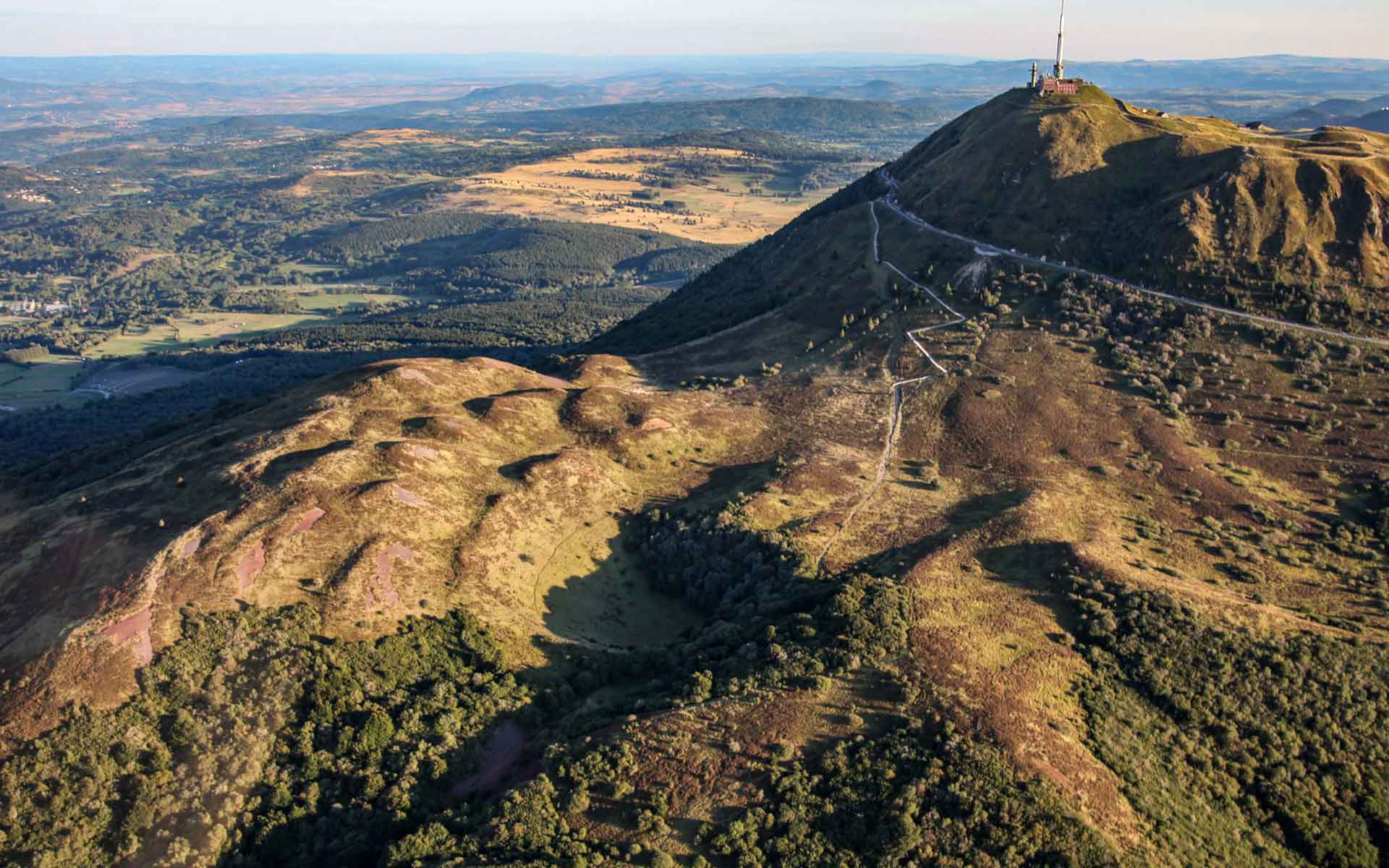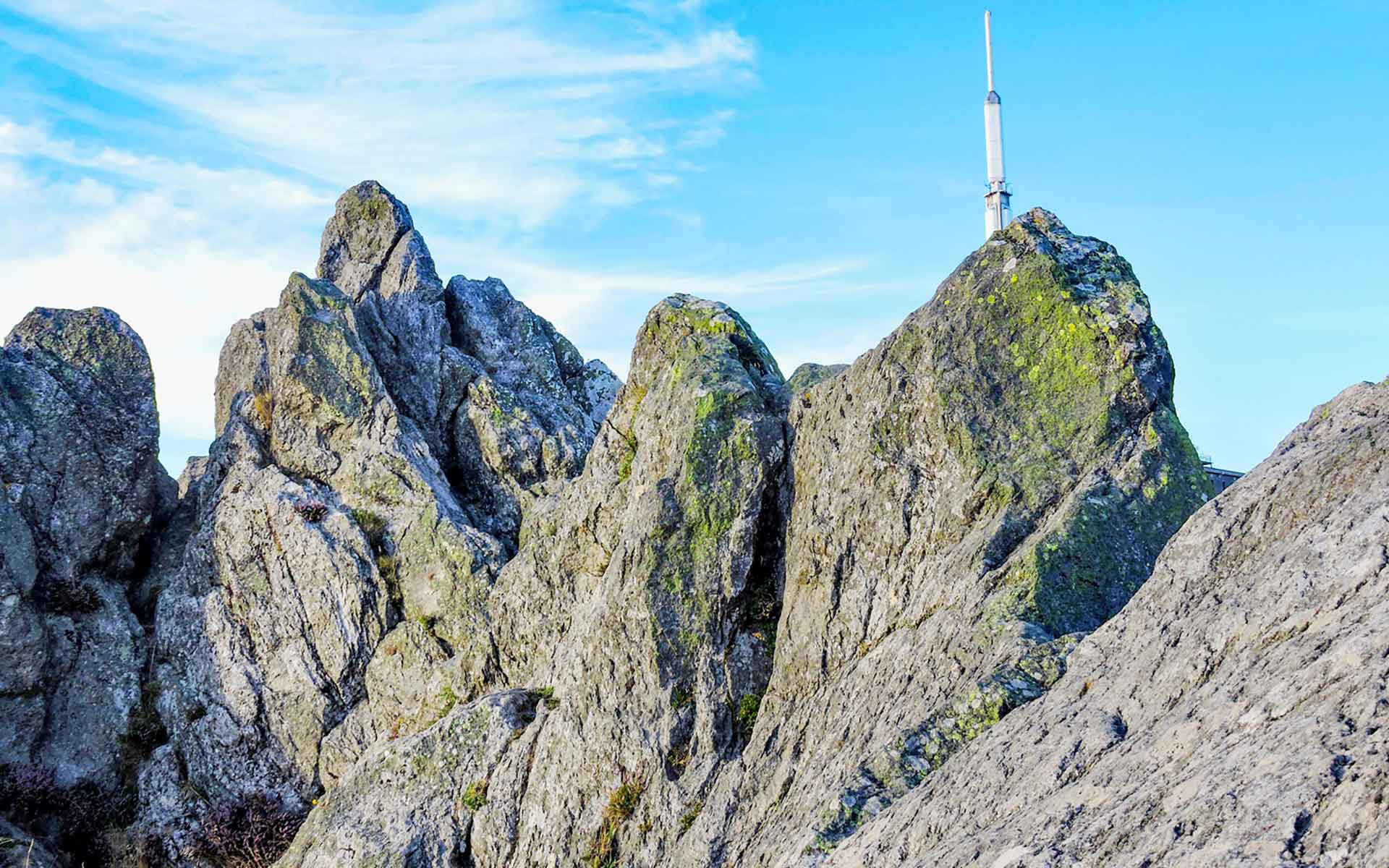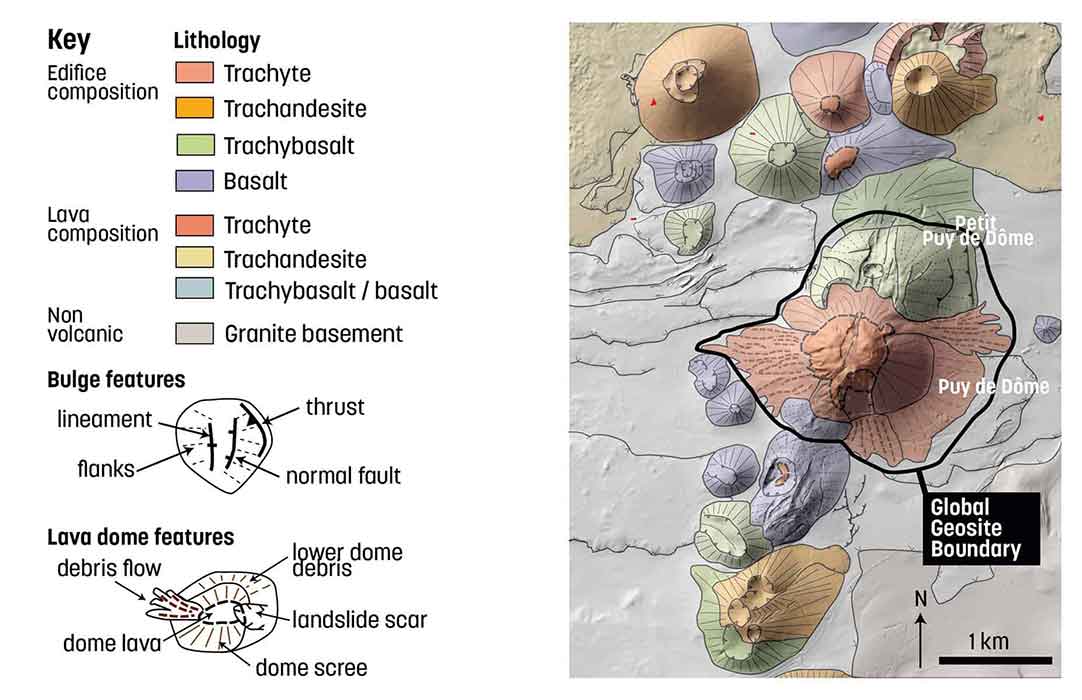
Oblique aerial view of the Petit-Puy-de-Dôme and Puy-de-Dôme from the NE (van Wyk de Vries et al., 2014).
Geological Period
Holocene
Main geological interest
History of geosciences
Volcanology
Location
Auvergne, France.
45°46’20.0″N, 2°57’52.0″E
Oblique aerial view of the Petit-Puy-de-Dôme and Puy-de-Dôme from the NE (van Wyk de Vries et al., 2014).
A world iconic riftrelated trachyte lava dome and the classic area for recognition of extinct volcanoes in historical geological debates.
This site was the first in which physical features were recognised as unambiguously volcanic in origin with demonstrable sequence of volcanic eruptions, depositional and erosional processes, all of which had evidently acted on a vast timescale. The site received attention during studies of physics and atmospheric scienes, and it is used as a geophysical standard. The site continues to be an exceptional locality for worldwide volcanological and geomorphological study, even after more than 250 years of research, and it is a type example of intrusion related uplift, and accompanying erupted edifice, which itself has been tilted by the bulging. The site is included in the Chaîne des Puys – Limagne fault tectonic arena UNESCO World Heritage.
- Geological description
The Puy-de-Dôme and Petit-Puy-de-Dôme constitute a volcano-tectonic landform oc-cupying the central part of the Chaîne des Puys-Limagne Fault UNESCO World Heritage site. It is a Grand Site de France located in the Auvergne Volcanoes Regional Nature Park, and it is listed in the French National Geoher-tiage inventory.
The Petit-Puy-de-Dôme is a classic bulged uplift created bf trachyte magma within pre-existing mono-genetic scoria cones (van Wyk de Vries et al., 2014). The bulge has steep sides, clear faults with a central graben and a late stage minor explosion crater.
The Puy-de-Dôme is probably the result of extrusion from the Petit-Puy-de-Dôme, and was subsequently tilted, as the bulge con-tinued te (Petronis et al., 2019). The dome had two eruptions separated by sev-eral hundred years, the main dome-forming complex magmatic assembly indicating mul-tiple intrusion phases (Deniel et al., 2020).
Emblematic site studied since the 18th cen-tury (e.g. Guettard, 1752; Desmarest, 1771), both volcanoes formed about 11,000 years ago (Miallier et al., 2010), and they are now evolving slowly as active processes, includ-ing occasinal rock falls and lahars, naturally modify their forms.
- Scientific research and tradition
This site was at the centre of 18th and 19th century volcanological debates and was studied by many major scientists such as Desmarest, von Buch, Scrope, Lyell and others (Taylor, 2007). Nowadays, this World Heritage Site continues to be used as a reference for geoscientific, physics and atmosphere research.
- Reference
Deniel, C. et al. (2020) ‘Multi-stage growth of the trachytic lava dome of the Puy de Dôme (Chaîne des Puys, France). Field, geomorphological and petro-geochemical evidence’, Journal of Volcanology and Geothermal Research, 396, p. 106749. Available at: https://doi.org/10.1016/j.jvolgeores.2019.106749.
Desmarest, N. (1771) ‘Mémoire sur l’origine et la nature du basalte à grandes colonnes polygones, déterminées par l’histoire naturelle de cette pierre, observée en Auvergne’, in Histoire et mémoires de l’Académie Royale des Sciences. Paris, pp. 705–775.
Guettard, J.-É. (1752) ‘Sur quelques montagnes de France qui ont été des volcans’, in Mémoire lu à l’Académie Royale des Sciences. Paris.
Miallier, D. et al. (2010) ‘The ultimate summit eruption of Puy de Dôme volcano (Chaîne des Puys, French Massif Central) about 10,700 years ago’, Comptes Rendus Geoscience, 342(11), pp. 847–854. Available at: https://doi.org/10.1016/j.crte.2010.09.004.
Petronis, M.S., van Wyk de Vries, B. and Garza, D. (2019) ‘The Leaning Puy de Dôme (Auvergne, France) tilted by shallow intrusions’, Volcanica, 2(2), pp. 161–186. Available at: https://doi.org/10.30909/vol.02.02.161186.
Taylor, K.L. (2007) ‘Geological travellers in Auvergne, 1751–1800’, Geological Society, London, Special Publications, 287(1), pp. 73–96.
van Wyk de Vries, B. et al. (2014) ‘Craters of elevation revisited: forced-folds, bulging and uplift of volcanoes’, Bulletin of Volcanology, 76(11), p. 875. Available at: https://doi.org/10.1007/s00445-014-0875-x.
- Author(s)
Benjamin van Wyk de Vries
Université Clermont Auvergne, Laboratoire Magmas et Volcans, OPGC, CNRS et IRD, Clermont Ferrand, France
Martin J.S. Rudwick
International Commission on the History of Geological Sciences (INHIGEO)
Kathleen Histon
International Commission on the History of Geological Sciences (INHIGEO)
Ezio Vaccari
International Commission on the History of Geological Sciences (INHIGEO) / Università degli Studi dell’Insubria
Nicolas CHARLES
PhD – BRGM / French Geological Survey


